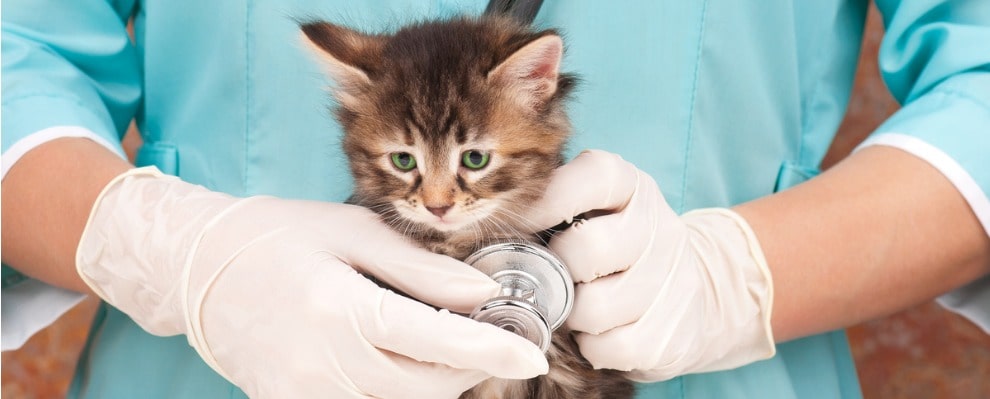Search Programs
When you click on a sponsoring school or program, or fill out a form to request information from a sponsoring school, we may earn a commission. View our advertising disclosure for more details.

Veterinary technicians and technologists are essential members of every veterinary clinic. They provide animal care, educate pet owners, and assist veterinarians with procedures. While this title may seem very straightforward, the education, training, and licensing level for professionals in this field varies widely and, in some states, is even regulated.
“When you look at nurses, they benefit from not only title protection but standardized education and examinations that everybody has to do. You can’t just walk into a hospital, work there for a year, get trained as a nurse, and then be called a nurse. That’s not how that works. But that is how it works for many veterinary technicians. Sometimes the training is not even a year. It’s only two weeks,” says Liz Hughston, a registered veterinary technician, co-chair of the Academy of Internal Medicine Veterinary Technicians’ credentialing committee, and president of the National Veterinary Professionals Union.
A 2022 report published by the National Association of Veterinary Technicians in America found that 40 percent of the veterinary technicians who responded to their survey about their state’s title protection laws answered incorrectly. The report also found that, at the time, 31 states had no title protection for veterinary technicians, and ten only had limited protection. This means that in well over half the states in the country, anyone can call themselves a veterinary technician with no legal ramifications.
“I’ve had two surgeries in the last three years,” shares Hughston. “For one, my anesthesia was managed by a CRNA. I know exactly what that credentialing entails. It’s clear that person is not a medical assistant. I know this person is not only an RN but an RN with additional training. An anesthesiologist managed the second surgery, which I know is an MD with additional training and certification. I understand what that entails. But when we say vet tech, it could mean any number of things. Some states allow you to practice as a veterinary technician with no licensing requirements. You could just have walked off the street.”
This lack of clarity and standardization around the title of veterinary technician causes many issues. “People are finally waking up to the fact that the staffing crisis in veterinary medicine is driven in large part by this lack of respect and protection for the title. It limits technicians’ earning potential because there’s no difference between someone coming off the street and being trained as a tech and someone who went to school and has a license. People get disheartened and don’t pursue licensure or certification because what’s the point? Why should they spend all that money on school or time when it doesn’t seem to matter?” asks Hughtston.
Keep reading to learn more about what title protection means, what benefits it can bring, and how to get involved.
Meet The Expert: Liz Hughston, RVT, CVT, LVT, LVMT, VTS

Liz Hughston is a registered veterinary technician as a co-chair of the Academy of Internal Medicine Veterinary Technicians’ credentialing committee, president of the National Veterinary Professionals Union, and co-founder of the Veterinary Cannabis Academy.
Hughston has been in the veterinary industry for more than 17 years, has been a prolific author of articles and textbook chapters, and has been co-editor for influential veterinary medicine publications. She actively advocates for veterinary technicians and assistants through her leadership positions, promoting their rights, mentorship, and professional development.
What is Title Protection?
“Title protection is reserving a specific title for people who have gone through the process to be licensed by a regulatory authority,” explains Hughston. Title protection is written into the state practice act for many professions, including licensed professional counselors, physical therapists, doctors, and more.
Currently, the standards to become a veterinary technician are inconsistent from state to state or, in many cases, non-existent. “In terms of universal title recognition and protection for veterinary technicians, it would include graduating from an AVMA-approved program, whether that be an associate’s or bachelor’s, and sitting for and passing the Veterinary Technician National Exam. States are allowed to put in any requirements after that, but I think we need to push for every state to implement those two pieces first,” she says
Standardization clarifies how to get into this profession and creates more value around a title that professionals have had to work for. “Right now, there is so much variation. There are still a number of alternate routes to licensure that don’t include education or testing. We need to reserve the title of ‘veterinary technician’ for the people who have the appropriate education and passed the national certifying exam,” says Hughston.
Title protection is written into the state’s practice act and will have legal ramifications for people who use the title without obtaining a license first. Also, ideally, along with enacting title protection, states will codify that tasks are restricted to licensed veterinary technicians to protect this profession further. Anyone who doesn’t hold the title won’t be able to perform specific duties, just as human nurses have protected tasks.
Benefits of Title Protection
Establishing title protection for veterinary technicians has many benefits. Here are some top reasons why title protection should be enacted nationwide.
Consumer Protection
If all veterinary technicians have standardized education and testing requirements, it provides consumer protection because they can trust that the person providing care for their pet is qualified: “In California, the Veterinary Medical Board is under the Department of Consumer Affairs because this is a consumer protection issue. And most pet owners don’t know that they could be handing their beloved family member over to someone with absolutely no formal education or training to do anesthesia, do dentistry, assist in surgery, or administer medications,” says Hughston.
“If veterinary technicians have title protection and can perform restricted jobs that are delegated appropriately, then you will be able to provide more value and confidence to clients.”
Better Retention in the Profession
Title protection for veterinary technicians will help elevate this career to a more professional one, with better pay and long-term job prospects. “It’s a matter of respect and recognition of the commitment to the profession. This is not just a job. It’s not a stepping stone to something better. It’s not something to do before you go to school. This is a full-fledged profession, and people can demonstrate that by becoming licensed. States can help by ensuring that the only people who can use the title are those who have committed to going to school, passing an exam, and getting licensed,” explains Hughston.
She continues,” In the end provides the profession with a group of people who are highly trained and highly educated. If we respect their titles and delegate to them appropriately to the fullest extent of their licensed training and education, then they’re going to stay in their career longer because they feel respected and valued. They see a career path for themselves. They see growth.”
This mutual respect will encourage veterinary technicians to stay on the job longer, which means they will have more knowledge and expertise. Currently, there is little incentive to stay since, in many states, anyone with an interest in this field can replace them.
More Income for Veterinary Practices
While credentialed veterinary technicians with title protection may cost clinics more money, they can generate significant revenues for their clinics in the long run. The AVMA notes that “research over the years has shown clear links between increased engagement of credentialed technicians and increased revenue.”
“They didn’t find similar gains in revenue with associate veterinarians, so this demonstrates how valuable a credential technician can be in terms of how much more efficient they can make the veterinarian,” notes Hughston. “As a vet tech, I can generate revenue by doing rechecks of straightforward things like ears or a urinary tract infection. The clinic can charge for each visit without needing the vet to present. Not only do you charge for the actual procedure or the lab test, but you charge for the technician’s time to do this.”
Shared Workload
Credentialed veterinary technicians with title protection and a clear scope of practice can help shoulder a lot of the workload in a veterinary clinic. “It frees up a veterinarian to do the things that make the most money for the practice, which are surgery, writing prescriptions, coming to a diagnosis, and delivering a prognostic plan,” says Hughston.
“Let the credential technicians do the things that they can do. Everybody gets out of work on time, clinics can see more patients, and clients don’t have long waits for appointments. For example, if a dog is scratching his head, they can see the technician who will take samples, review the samples, and can tell the doctor the findings. The doctor can then confirm it, or they can look at the microscope if they have more questions. They can then prescribe the medication, and the technician gives the client the prescription and does the client education on how to clean the ears and put the medication in. All the veterinarian had to do was maybe look at a slide,” she says.
Increased Trust
Standardized title protection will help increase confidence between veterinary technicians, veterinarians, and clients. “I think one of the reasons that a lot of duties aren’t handed off to vet techs is because we have many of these people who call themselves vet techs without the education, experience, or training. And so there’s a trust deficit. Veterinarians don’t know who to delegate to if the practice doesn’t hire credentialed techs. They don’t want to risk their license by delegating to someone who doesn’t have the skills. They will want to do everything themselves because they don’t know who is capable. With title protection, only people who have fulfilled the educational requirements, the training, and the exam and have become credentialed will be allowed to call themselves veterinary technicians. Then the veterinarian can have confidence that they are delegating things to a capable person,” explains Hughston.
How To Get Involved
There are many different ways to get involved in this push for title protection. “Veterinary technicians should get involved in their state’s veterinary technician association and veterinary medical association. This is where these discussions and legislative change can come from. Legislators, for the most part, don’t care about individuals—they care about organizations. Working in these organizations to create the change that you want to see in your state.”
Veterinarians can also get involved in title protection efforts. “From veterinarians, we need them to respect our titles. I have heard veterinarians say, ‘I don’t want anybody on my team to feel bad, so we just call everybody a technician.’ They should be calling them assistants if they aren’t credentialed, and we have to recognize the difference between the two, including what we call them. We need to get away from the emotion involved with the title and instead focus on the legality of the title,” says Hughston. “Then veterinarians need to restrict the use of technician to those who have a credential and follow their state’s practice act in terms of the rules of delegation.”
Lastly, the general public can also get involved. “When you take your pet to the vet, ask how many credentialed veterinary technicians work in the practice. If the answer is none, ask them why. If we can also drive this issue from the public side, it will make a big difference, “ says Hughston.
“The public should know what is happening at the hospital, who is cleaning their pet’s teeth, who is going to be putting a pet under anesthesia, who is going to be monitoring that anesthesia. The roles in the clinic should be clear, and pet owners can start to push for credentialed veterinary technicians to care for their pets. That will greatly help add recognition to the veterinary technician title.”

